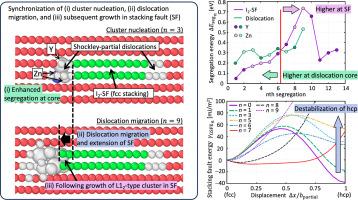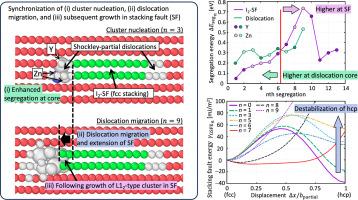Formation mechanism of cluster-arranged layers in Mg-Y-Zn alloy: A density functional theory study
IF 13.8
1区 材料科学
Q1 METALLURGY & METALLURGICAL ENGINEERING
引用次数: 0
Abstract
A sparsely introduced basal intrinsic 2-type stacking fault (I2-SF) with a dense segregation of clusters (cluster-arranged layer; CAL) in α-Mg exerts a sufficient strengthening effect with a reduced content of additive elements. Moreover, the dynamic nucleation and growth of CALs during deformation largely improves the creep resistance. This paper analyzes the cosegregation behaviors of yttrium (Y) and zinc (Zn) atoms at an I2-SF in bulk and at basal edge dislocations using density functional theory calculations. We also study the modification of the generalized stacking-fault energy (GSFE) curves associated with the cosegregation. The segregation energies of Y and Zn atoms in the I2-SF are relatively small during the initial segregation of a cluster, but increases stepwise as the cluster grows. After introducing Y and Zn atoms in the I2-SF in an energetically stable order, we obtain an L12-type cluster resembling that reported in the literature. Small structural changes driven by vacancy diffusion produce an exact L12-type cluster. Meanwhile, the core of the Shockley partial dislocation generates sufficient segregation energy for cluster nucleation. Migration of the Shockley partial dislocation and expansion of the I2-SF part are observed at a specific cluster size. The migration is triggered by a large modification of the GSFE curve and destabilization of the hexagonal close-packed stacking (hcp) by the segregated atoms. At this point, the cluster has reached sufficient size and continues to follow the growth in the I2-SF part. According to our findings, the CAL at elevated temperature is formed through repeated synchronized behavior of cluster nucleation at the Shockley partial dislocation, dislocation migration triggered by the destabilized hcp stacking, and following of cluster growth in the I2-SF part of the dislocation.


Mg-Y-Zn合金中团簇层形成机理:密度泛函理论研究
一个稀疏引入的基底本征2型层错(I2-SF),具有密集的团簇(团簇排列层;随着添加元素含量的降低,α-Mg中的CAL具有足够的强化作用。此外,变形过程中CALs的动态形核和生长大大提高了材料的抗蠕变能力。本文用密度泛函理论计算分析了钇(Y)和锌(Zn)原子在I2-SF体位和基边位错处的共偏析行为。我们还研究了与共偏析相关的广义叠加-断层能(GSFE)曲线的修正。在I2-SF中,Y和Zn原子的偏析能在团簇的初始阶段相对较小,但随着团簇的增长逐渐增加。在I2-SF中以能量稳定的顺序引入Y和Zn原子后,我们得到了与文献报道相似的l12型簇。由空位扩散驱动的微小结构变化产生精确的l12型簇。同时,肖克利部分位错的核心为团核形成提供了足够的偏析能。在一定的团簇尺寸下,观察到肖克利位错部分的迁移和I2-SF部分的膨胀。迁移是由GSFE曲线的大幅度改变和分离原子对六方密排堆积(hcp)的破坏引起的。此时,集群已经达到足够的规模,并继续跟随I2-SF部分的增长。根据我们的研究结果,高温下的CAL是通过在肖克利部分位错处重复的团核同步行为、不稳定的hcp堆叠引发的位错迁移以及位错的I2-SF部分的团簇生长而形成的。
本文章由计算机程序翻译,如有差异,请以英文原文为准。
求助全文
约1分钟内获得全文
求助全文
来源期刊

Journal of Magnesium and Alloys
Engineering-Mechanics of Materials
CiteScore
20.20
自引率
14.80%
发文量
52
审稿时长
59 days
期刊介绍:
The Journal of Magnesium and Alloys serves as a global platform for both theoretical and experimental studies in magnesium science and engineering. It welcomes submissions investigating various scientific and engineering factors impacting the metallurgy, processing, microstructure, properties, and applications of magnesium and alloys. The journal covers all aspects of magnesium and alloy research, including raw materials, alloy casting, extrusion and deformation, corrosion and surface treatment, joining and machining, simulation and modeling, microstructure evolution and mechanical properties, new alloy development, magnesium-based composites, bio-materials and energy materials, applications, and recycling.
 求助内容:
求助内容: 应助结果提醒方式:
应助结果提醒方式:


